Dynamic formation and transcriptional regulation mediated by phytohormones during chalkiness formation in rice
- PMID: 34193032
- PMCID: PMC8247166
- DOI: 10.1186/s12870-021-03109-z
Dynamic formation and transcriptional regulation mediated by phytohormones during chalkiness formation in rice
Abstract
Background: Rice (Oryza sativa L.) Chalkiness, the opaque part in the kernel endosperm formed by loosely piled starch and protein bodies. Chalkiness is a complex quantitative trait regulated by multiple genes and various environmental factors. Phytohormones play important roles in the regulation of chalkiness formation but the underlying molecular mechanism is still unclear at present.
Results: In this research, Xiangzaoxian24 (X24, pure line of indica rice with high-chalkiness) and its origin parents Xiangzaoxian11 (X11, female parent, pure line of indica rice with high-chalkiness) and Xiangzaoxian7 (X7, male parent, pure line of indica rice with low-chalkiness) were used as materials. The phenotype, physiological and biochemical traits combined with transcriptome analysis were conducted to illustrate the dynamic process and transcriptional regulation of rice chalkiness formation. Impressively, phytohormonal contents and multiple phytohormonal signals were significantly different in chalky caryopsis, suggesting the involvement of phytohormones, particularly ABA and auxin, in the regulation of rice chalkiness formation, through the interaction of multiple transcription factors and their downstream regulators.
Conclusion: These results indicated that chalkiness formation is a dynamic process associated with multiple genes, forming a complex regulatory network in which phytohormones play important roles. These results provided informative clues for illustrating the regulatory mechanisms of chalkiness formation in rice.
Keywords: Chalkiness; Dynamic formation; Phytohormones; Rice; Transcriptional regulation.
Conflict of interest statement
The authors declare that they have no competing interests.
Figures

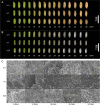

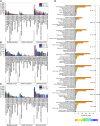
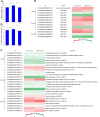
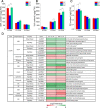


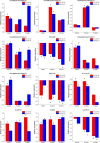
Similar articles
-
Transcriptome analysis of grain-filling caryopses reveals involvement of multiple regulatory pathways in chalky grain formation in rice.BMC Genomics. 2010 Dec 30;11:730. doi: 10.1186/1471-2164-11-730. BMC Genomics. 2010. PMID: 21192807 Free PMC article.
-
Complementary Proteome and Transcriptome Profiling in Developing Grains of a Notched-Belly Rice Mutant Reveals Key Pathways Involved in Chalkiness Formation.Plant Cell Physiol. 2017 Mar 1;58(3):560-573. doi: 10.1093/pcp/pcx001. Plant Cell Physiol. 2017. PMID: 28158863 Free PMC article.
-
Proteomic analysis of proteins related to rice grain chalkiness using iTRAQ and a novel comparison system based on a notched-belly mutant with white-belly.BMC Plant Biol. 2014 Jun 12;14:163. doi: 10.1186/1471-2229-14-163. BMC Plant Biol. 2014. PMID: 24924297 Free PMC article.
-
[Current status and strategies for improvement of rice grain chalkiness].Yi Chuan. 2009 Jun;31(6):563-72. doi: 10.3724/sp.j.1005.2009.00563. Yi Chuan. 2009. PMID: 19586854 Review. Chinese.
-
Relationship between High Temperature and Formation of Chalkiness and Their Effects on Quality of Rice.Biomed Res Int. 2018 Apr 1;2018:1653721. doi: 10.1155/2018/1653721. eCollection 2018. Biomed Res Int. 2018. PMID: 30065932 Free PMC article. Review.
Cited by
-
Transcriptome and Physiological Analysis Reveals the Mechanism of Abscisic Acid in Regulating Cadmium Uptake and Accumulation in the Hyperaccumulator Phytolacca acinosa Roxb.Plants (Basel). 2025 May 8;14(10):1405. doi: 10.3390/plants14101405. Plants (Basel). 2025. PMID: 40430971 Free PMC article.
-
Transcriptome Analysis Reveals Quality Improvement Mechanisms in Ratoon Rice.Foods. 2025 Aug 19;14(16):2873. doi: 10.3390/foods14162873. Foods. 2025. PMID: 40870785 Free PMC article.
-
Transcriptome and Metabolome Analyses Reveals the Pathway and Metabolites of Grain Quality Under Phytochrome B in Rice (Oryza sativa L.).Rice (N Y). 2022 Oct 27;15(1):52. doi: 10.1186/s12284-022-00600-5. Rice (N Y). 2022. PMID: 36302917 Free PMC article.
-
Haplotype Analysis of the GL7/GW7/SLG7 Gene and Its Application in Improving the Grain Quality of Three-Line Hybrid Rice.Rice (N Y). 2025 May 23;18(1):38. doi: 10.1186/s12284-025-00786-4. Rice (N Y). 2025. PMID: 40407831 Free PMC article.
-
Energy Deficiency and Misdistribution Leads to Disrupted Formation in Grain Yield and Rice Quality.Int J Mol Sci. 2024 Nov 27;25(23):12751. doi: 10.3390/ijms252312751. Int J Mol Sci. 2024. PMID: 39684462 Free PMC article.
References
-
- Kim SS, Lee SE, Kim OW, Kim DC. Physicochemical characteristics of chalky kernels and their effects on sensory quality of cooked rice. Cereal Chem. 2000;77(3):376–379. doi: 10.1094/CCHEM.2000.77.3.376. - DOI
-
- Ishimaru T, Horigane AK, Ida M, Iwasawa N, San-oh YA, Nakazono M, Nishizawa NK, Masumura T, Kondo M, Yoshida M. Formation of grain chalkiness and changes in water distribution in developing rice caryopses grown under high-temperature stress. J Cereal Sci. 2009;50(2):166–174. doi: 10.1016/j.jcs.2009.04.011. - DOI
-
- Lin Z, Zheng D, Zhang X, Wang Z, Lei J, Liu Z, Li G, Wang S, Ding Y. Chalky part differs in chemical composition from translucent part of japonica rice grains as revealed by a notched-belly mutant with white-belly. J Sci Food Agric. 2016;96(11):3937–3943. doi: 10.1002/jsfa.7793. - DOI - PMC - PubMed
MeSH terms
Substances
LinkOut - more resources
Full Text Sources

